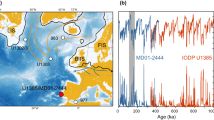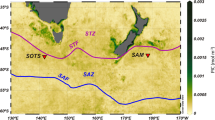Abstract
PRYMNESIOPHYTE algae, which include the coccolithophorid species Emiliania huxleyi1, are the recognized biological source of a series of long-chain (C37, c38, 39, unsaturated methyl and ethyl ketones2 widely observed in marine sediments3. Studies of E. huxleyi in culture have demonstrated that these biomarkers are attractive geochemical tools for palaeoceanographic study. No-tably, unsaturation patterns within the alkenone series change regularly with growth temperature3–5 and the total alkenone abundance in the living plant cell is relatively constant, accounting for 5–10% of the total cellular organic carbon5. If these com-pounds are relatively well-preserved in sediments, profiles of alkenone unsaturation patterns and total alkenone concentration with depth in dated deep-sea cores6–8 provide a temporal record of sea surface temperatures and the productivity of an important group of marine phytoplankton3–5. Here we analyse the long-chain alkenone composition of sediment samples from above and below an oxidation front in an ungraded turbidite layer9 deposited 140 ±12 kyr BP in the Madeira Abyssal Plain10, to evaluate the post-depositional stability of these biomarkers under contrasting redox conditions. The results demonstrate that >85% of the total amount of these compounds is degraded over ∼8 kyr as a consequence of diffusion-controlled oxidation10. Remarkably, such extensive degradative loss has little effect on the unsaturation pattern of the residual biomarker series. Thus, we find that long-chain alkenones provide reliable indicators of sea surface temperature in the ocean. The total abundance of these biomarkers in sediments, however, is controlled not only by prymnesiophyte productivity, but also by their degree of exposure to oxidative degradation in the sedimentary process.
This is a preview of subscription content, access via your institution
Access options
Subscribe to this journal
Receive 51 print issues and online access
$199.00 per year
only $3.90 per issue
Buy this article
- Purchase on Springer Link
- Instant access to full article PDF
Prices may be subject to local taxes which are calculated during checkout
Similar content being viewed by others
References
Okada, H. & Honjo, S. Deep Sea Res. 26, 355–374 (1973).
Marlowe, I. T. et al. Br. phycol. J. 19, 203–216 (1984).
Brassell, S. C. et al. Nature 320, 129–133 (1986).
Prahl, F. G. & Wakeham, S. G. Nature 330, 367–369 (1987).
Prahl, F. G., Muehlhausen, L. A. & Zahnle, D. L. Geochim. cosmochim. Acta 52, 2303–2310 (1988).
Farrington, J. W. et al. Org. Geochem. 13, 607–617 (1988).
Jasper, J. P. thesis, Woods Hole Oceanographic Institution (1988).
Prahl, F. G., Muehlhausen, L. A. & Lyle, M. W. Paleoceanography (in the press).
Wilson, T. R. S. et al. Geochim. cosmochim. Acta 49, 811–822 (1985).
Buckley, D. E. & Cranston, R. E. Geochim. cosmochim. Acta 52, 2925–2939 (1988).
de Lange, G. J., Jarvis, I. & Kuipers, A. in Geology and Geochemistry of Abyssal Plains, Geol. Soc., Spec. publ. 31, 147–161 (1987).
Weaver, P. P. E. & Kuipers, A. Nature 306, 360–363 (1983).
Weaver, P. P. E. & Rothwell, R. G. in Geology and Geochemistry of Abyssal Plains, Geol. Soc., Spec. publ. 31, 71–86 (1987).
McCave, I. N. & Jones, K. P. N. Nature 333, 250–252 (1988).
Thomson, J. et al. in Geology and Geochemistry of Abyssal Plains, Geol. Soc., Spec. publ 31, 167–177 (1987).
ten Haven, H. L. et al. Mar. Geol. 75, 137–156 (1987).
Volkman, J. K. et al. in Advances in Organic Geochemistry 1981 (ed. Bjoroy, M.) 228–240 (Wiley, 1983).
Prahl, F. G. & Muehlhausen, L. A. in Productivity in the Oceans: Present and Past (eds Berger, W. H., Smetacek, V. S. & Wefer, G.) 271–289 (Wiley, 1989).
Suess, E. Nature 288, 260–263 (1980).
Emerson, S. in The Carbon Cycle and Atmospheric CO2: Natural Variations Archaen to Present (eds Sundquist, E. T. & Broecker, W. S.) 78–87 (American Geophysical Union, 1985).
Finney, B. P., Lyle, M. W. & Heath, G. R. Paleoceanography 3, 169–189 (1988).
Haxo, F. T. J. Phycol. 21, 282–287 (1985).
Weliky, K. et al. Limnol. Oceanogr. 28, 1252–1259 (1983).
Author information
Authors and Affiliations
Rights and permissions
About this article
Cite this article
Prahl, F., de Lange, G., Lyle, M. et al. Post-depositional stability of long-chain alkenones under contrasting redox conditions. Nature 341, 434–437 (1989). https://doi.org/10.1038/341434a0
Received:
Accepted:
Issue Date:
DOI: https://doi.org/10.1038/341434a0
This article is cited by
-
Assessing the UK′37-sea surface temperature relationship in shallow marine waters
Science China Earth Sciences (2023)
-
Biomarkers in the rock outcrop of the Kazusa Group reveal palaeoenvironments of the Kuroshio region
Communications Earth & Environment (2021)
-
Strong glacial-interglacial variability in upper ocean hydrodynamics, biogeochemistry, and productivity in the southern Indian Ocean
Communications Earth & Environment (2021)
-
Cold-induced metabolic conversion of haptophyte di- to tri-unsaturated C37 alkenones used as palaeothermometer molecules
Scientific Reports (2018)
-
Tightly linked zonal and meridional sea surface temperature gradients over the past five million years
Nature Geoscience (2015)
Comments
By submitting a comment you agree to abide by our Terms and Community Guidelines. If you find something abusive or that does not comply with our terms or guidelines please flag it as inappropriate.



